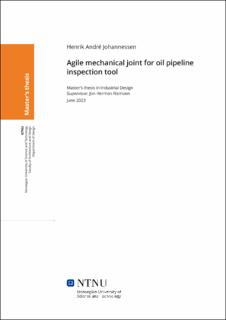Agile mechanical joint for oil pipeline inspection tool
Master thesis
Permanent lenke
https://hdl.handle.net/11250/3078475Utgivelsesdato
2023Metadata
Vis full innførselSamlinger
- Institutt for design [1086]
Sammendrag
Denne avhandlingen brukte “Design Thinking” prosessen for å skape et forbedret mekanisk ledd, etter spesifikke designkriterier bestemt gjennom å utforske ROSEN Norge og engasjement med deres ansatte. Gjennom en iterativ designprosess ble ulike konsepter realisert ved bruk av 3D-printing teknologi og gjennomgikk praktisk testing for å få innsikt til videre iterasjoner. Denne syklusen fortsatte til "Triple Joint" designet ble realisert. Designet ble videre optimalisert ved hjelp av Generative Design for å minimere vekt, redusere indre stress og opprettholde sikkerhetsgrenser. Studien resulterte i tre nøkkelfunn: den speilvendte bevegelsen i “Twin joint” som gir smidighet, stabilitet og kontroll; introduksjonen av “Triple rod” som reproduserer denne bevegelsen i en ekstra dimensjon; og implementeringen av pinnene, som hjalp med å eliminere den katastrofale feilen i et slikt design. Forskningsprosessen ble primært muliggjort av rask 3D-prototyping. Imidlertid erkjenner studien mangelen på testing i reell skala som en begrensning og anbefaler fremtidig testing av leddet, laget av 3D-printet titan, mot kreftene det er designet for å tåle og sterkere. I tillegg kunne utforming av ledd for kompatibilitet med diverse moduler forbedre anvendeligheten av fremtidig arbeid. This thesis utilized the Design Thinking process to create an improved mechanical joint, with specific design criteria determined by exploring ROSEN Norway and engagement with its employees. Through an iterative design process, various concepts were brought to life using 3D printing technology and underwent practical testing to glean insights for further iterations. This cycle continued until the “Triple Joint” design was realized. The design was further optimized using Generative Design to minimize weight, reduce internal stresses, and uphold safety limits. The study yielded three key findings: the mirrored motion in the “Twin joint” providing agility, stability, and control; the introduction of the “Triple rod” replicating this motion in an extra dimension; and the implementation of the pins, which helped eliminate the catastrophic flaw in such a design. The research process was primarily enabled by rapid 3D prototyping. However, the study acknowledges the lack of testing at a real-world scale as a limitation and recommends future testing of the joint, made from 3D-printed titanium, against the forces it is designed to endure and beyond. Additionally, designing joints for compatibility with diverse modules could improve the applicability of future work.
